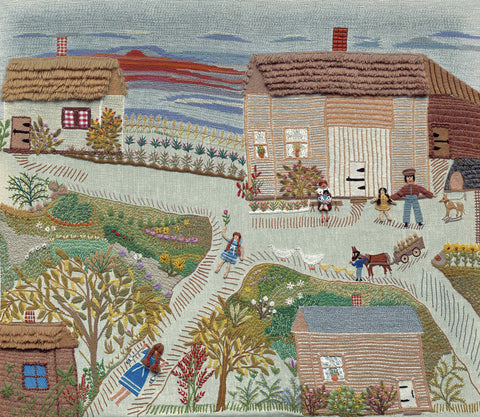
This Holocaust Survivor Told the Horrors of War With Fabric and Thread
E sther Krinitz (1927-2001) just wanted her children to know what her home had looked like before the war. It was 1977, and the Holocaust survivor, a 50-year-old dress designer and seamstress in Brooklyn, New York, owned no childhood photos but had a vivid memory and talent to spare: “She had never been trained as an artist,” recalls daughter Bernice Steinhardt. “But she could sew anything.”
Using a large piece of fabric as her canvas, Esther drew the pastoral village of Mniszek in northern Poland, where she, along with her parents, four siblings, grandparents, and cousins, had lived until genocide upended their lives. She filled inside the lines with embroidery and fabric scraps and was so pleased with the result that she made a second artwork, this one showing her swimming in Poland’s Vistula River in the 1930s with older brother Ruven.
Stitching these scenes, which she gifted to daughters Steinhardt and Helene McQuade, inspired Esther to document even more recollections from her past. She’d go on to create a total of 36 fabric-art segments throughout the next three decades, depicting not just her relatives and birthplace but her own narrow escape from the Nazis.
Sewn sporadically and in no particular order, the panels nonetheless tell a chronological story of Esther and her younger sister Mania, who evaded a Gestapo roundup in 1942 and spent the war’s remainder pretending to be Catholic farm girls. The two eventually immigrated to the U.S. Their family, tenderly immortalized throughout Esther’s series, wasn’t so fortunate: they likely perished at concentration camps.
Here and on the following pages are a sampling of Esther’s artworks, all on view in the exhibit “Esther and the Dream of One Loving Human Family” at Baltimore’s American Visionary Art Museum through March 3, 2024.
Esther
Krinitz
Life changed forever for
Esther Krinitz’s family when the Nazis entered her Polish village on horseback
in September 1939. Esther, shown here at age 12, watched from afar with
friends as the men rode up to her grandparents’ home. A soldier dismounted
and, approaching her grandfather, sliced off his beard.
On October 15, 1942, following three years of
rising persecution, the Gestapo ordered all Jews in Mniszek and neighboring
Rachow (today Annapol) to depart for Krasnik railroad station. Esther and
Mania (below right) didn’t join them, waving goodbye as their family’s wagons
rolled away toward an uncertain future. Their farewell that day wound up being
final.
Esther and Mania had an
escape plan in place: their mother had paid a neighbor to take them to
Dombrowa, Poland, where their father’s friend Stefan lived. After the escort
abandoned them, the siblings headed to Stefan’s home on their own. But while
initially welcoming, he soon cast them out into the forest (below right).
Mania and Esther remained on the run until early November, when they arrived
at the village of Grabówka and found work by pretending to be Catholic farm
girls.
Esther received help from an
unlikely ally in June 1943 while gardening at a farm in Grabówka. Two Nazi
soldiers approached and wanted to talk; afraid they’d discover her true
identity, she remained silent as a cloud of honeybees swarmed the men and
drove them away. “Why aren’t they stinging you?” they asked Esther’s employer,
an elderly man named Dziadek, who stood by observing the one-sided exchange.
Esther experienced a powerful dream in 1944
while in hiding, one that made such an impression she rendered it in fabric 45
years later. The scene unfolded inside her grandfather’s house; knowing he’d
died three years prior, Esther said to him in the dream, “Oh Zayde, you are
close to God! You have to help me!” “Don’t worry, Esther,” he replied. “You
will cross the river and you will be safe.”
Esther and her sister Mania left
hiding in July 1944 after the Russian Army liberated Grabówka. They visited
their home village, Mniszek, and then Maidanek death camp in search of
surviving kin. The artwork below shows the crematorium director’s house, now a
charred mound of rubble; its showers and gas chambers; and, in the distance,
cabbage crops fertilized with human remains. “I looked through the piles of
worn shoes but they all looked the same,” Esther later recalled.
As her grandfather foretold in her dream, Esther
wound up crossing a river to safety. In March 1945, she and Mania accompanied
a Polish army unit that, along with the Russian Army’s Fifth Division, drove
over the Oder River into Germany, passing executed Nazi officers along their
route. The two later sought refuge in the village of Ziegenhain, at the
displaced persons camp where Esther would meet and marry husband Max Krinitz
in 1946.
In 1999, Esther returned to Poland with her
extended American family for the first time since the war. Her health declined
following the trip, and in 2001 she died at age 74. Since then Esther’s art
has been exhibited by museums and organizations around the world. It can also
be viewed online via the family-run Art & Remembrance, a D.C.-based
educational and arts nonprofit (artandremembrance.org).
this article first appeared in world war II magazine
From the Winter 2023 issue of World War II.
